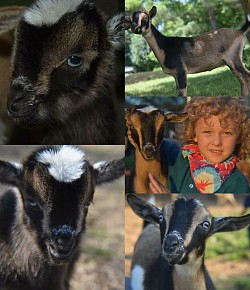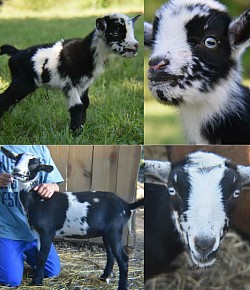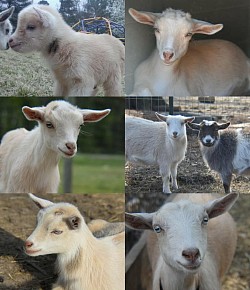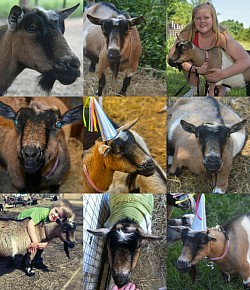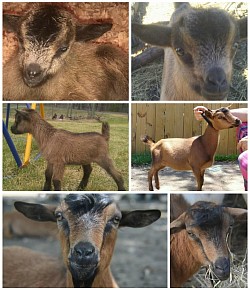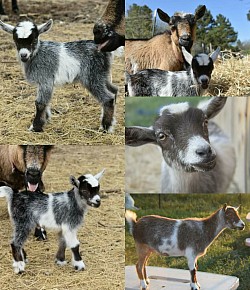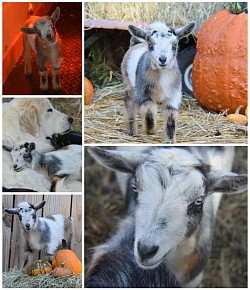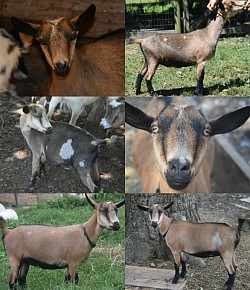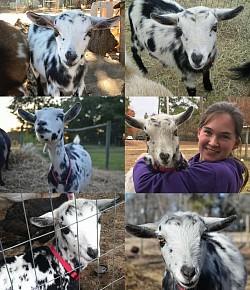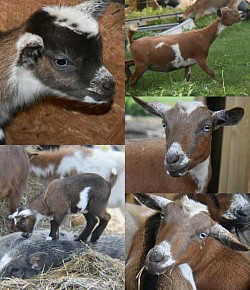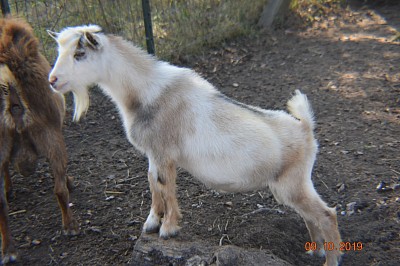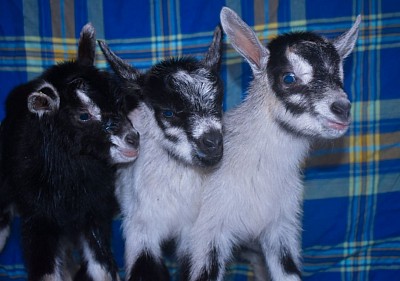Color Genetics Education Contest!
Color Genetics Simplified
Information:
I'm going to try to explain this in the easiest way to understand! When we discuss genetics, we know some genes are recessive, some dominant, and some codominant.
Recessive means it takes contribution from BOTH parents to pass on to the offspring.
Dominant means it only takes one parent to pass it to the offspring.
Codominant basically means it is a gene willing to share its space with another gene and work together to both show in the offspring.
In goats, some gene examples that are dominant are Blue eyes and Polled.
A baby goat MUST have one parent who is blue eyed or polled to pass on. They cannot pass a gene they do not have!
Moonspots are the colorful random spots of color that are not black or white mixed in the goats normal coat color. Many times perfect circles but can be splotches and sometimes cover large patches of the goat. (Silver, chocolate, tan, or cream usually) It takes one parent to pass moonspots also, but sometimes their spot can be as few as a single spot to pass on super colorful kids.
Wattles are like goat jewelry. They are the little skin tag like hanging things on a goats neck close to her head. They have no function, but I've noticed babies use their moms wattles as pacifiers! Wattles are something else a goat must have to pass on.
Most goat patterns are on the agouti allele. Basically, you need to know that allele has 2 "place holders" that can be a combination of any pattern, OR one pattern and a hidden recessive black gene. To get a black goat BOTH parents must carry a gene for black. If a goat is black, it has 2 copies of the gene so its "place holders" are filled and it cannot be hiding any other pattern.
The first color example we have is Fantasia, a Red Buckskin with blue eyes and some moonspots.
That means she has one gene for buckskin and one gene for chamoisee with the unknown modifier gene, and the dominant blue eyes and moonspots. ALL her kids will either be buckskin OR chamoisee no matter what goat she is bred to.
(Using punnett squares we know she is a Bb(heterozygous) blue eyed goat. That means she only has 1 copy of the blue eye gene(B), and one for brown (b).
BB is homozygous blue, meaning no matter what they will ALWAYS have a blue eyed kids. bb is brown.)
Buckskin- Black front half, light rear half, light stripes on face, light legs.
A buckskin goat will either have buckskin kids or black if they are carrying black. If the contribute their black gene, and the other parent is a different pattern not carrying black, kids may come out the other parents pattern. BUT Buckskin will only contribute buckskin or black.
Chamoisee- black belly, black dorsal(back stripe), black legs, and black facial markings on a lighter color body
A chamoisee goat will either have chamoisee kids or black if they carry black.
Buckskin and Chamoisee- A combination of both patterns without the modifier gene, is a mostly solid animal with darker leg markings, a dark dorsal stripe, some dark facial markings. They lose the buckskin Cape and light stripes on the face, and they lose the chamoisee black belly and solid legs. They mute out each other trying to both show thru.
The combination means one parent was a buckskin or buckskin combination pattern, and kne parent was chamoisee or chamoisee combination. A buckskin chamoisee can NOT have black kids, because both "place holders " were used by patterns and left no room for recessive black.
Gold- Any shade from light cream to red is genetically considered gold.
Gold is dominant and can cover over and hide patterns. If a gold goat has 2 gold parents they can have both gold genes and will ONLY produce gold kids. They can also be gold and have a hidden buckskin or chamoisee pattern gene. The best way to know would be breeding a gold goat to black! (Then you know all colors and patterns that show up in the kids are carried or hiding in the gold parent because black can ONLY contribute black)
Chocolate- From light brown to rich dark chocolate, this is a black modifier. Chocolate can work with color patterns and all areas of a coat that would normally be black, will be chocolate color instead. Chocolate, like black can only contribute chocolate. Many times these goats drastically change as they grow. Ocassionally chocolate pattern goats will mature to a solid chocolate appearance.


